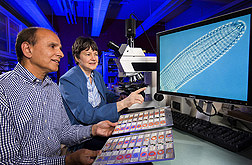Roundworm Repository Provides “Ag Insurance”
The USDA Nematode Collection—maintained by ARS’s Nematology Laboratory in Beltsville, Maryland—contains more than 43,000 roundworm-containing microscope slides and vials, making it one of the world’s largest and most treasured repositories of its kind.
Enhancing that collection’s value further is the expertise of the lab’s six scientists who, together with support staff, maintain the repository for systematic studies, taxonomic classifications, and training purposes and provide expert species identification for regulatory agencies such as USDA’s Animal and Plant Health Inspection Service (APHIS).
Nematode specimens with requests to identify them are submitted often. In 2008, for example, ARS microbiologist Zafar A. Handoo identified nearly 700 samples, including nearly 300 sent by APHIS personnel at ports of entry or from domestic surveys.
Another use is conducting pest-control research. ARS physiologist Edward P. Masler, for example, has identified nematode signaling molecules, called “amines,” that may yield new, eco-friendly controls for crop-damaging species like Heterodera glycines, which costs U.S. soybean farmers $1 billion annually in losses.
Besides plant-parasitic species, the collection includes nematodes that feed on microbes and insects. There is also a live collection—studied by ARS plant pathologist Lynn K. Carta—of bacterial-feeding nematodes, many of which can live in insects. Since 2000, Carta has identified seven associated species from the invasive Formosan subterranean termite as well as nematodes from various beetles and tarantulas. Some of these may prove useful in battling pests with biocontrol agents.
Preparing specimens for identification can be time consuming. Many nematodes sport similar-looking mouthparts, tail tips, and other microscopic characteristics useful for identification. “Because nematode species can overlap with respect to these characteristics, it takes an expert with years of experience and a collection of bona fide reference specimens to identify them,” says David J. Chitwood, who leads the laboratory.
It helps, though, to have a resident DNA detective. Using the latest polymerase chain reaction procedures, ARS molecular biologist Andrea Skantar complements morphological identification of nematodes by “lifting” their genetic “fingerprints” from DNA samples. Even then, Skantar cautions, “Your molecular diagnosis is only as good as the information from known species used for comparison.”
That attention to detail, together with the lab’s extensive database of information on the collection’s specimens, helps to safeguard American agriculture and ensure free trade with other countries.
A well-known example occurred in 2000, when Nematology Laboratory scientists met with a visiting Brazilian delegation in response to a ban Brazil had imposed on U.S. wheat imports for fear of introducing the seed gall nematode, Anguina tritici.
A turning point came when the researchers discovered a single slide of a specimen that a port inspector had submitted in 1953. A database search revealed the genus, Anguina, the host plant from which it had been isolated, reedgrass, and most importantly, the country of origin, Brazil. The country, in turn, lifted its ban, reopening a $50-200 million annual market for U.S. wheat.
“Had that slide not been in our collection, the market could have remained closed,” Chitwood says. “That’s the value of the collection.”—By Jan Suszkiw, Agricultural Research Service Information Staff.
This research is part of Plant Diseases (#303) and Pasture, Forage, and Range Land Systems (#215), two ARS national programs described at www.nps.ars.usda.gov.
To reach scientists featured in this article, contact Jan Suszkiw, USDA-ARS Information Staff, 5601 Sunnyside Ave., Beltsville, MD 20705-5129; (301) 504-1630.
"Roundworm Repository Provides “Ag Insurance”" was published in the January 2010 issue of Agricultural Research magazine.







